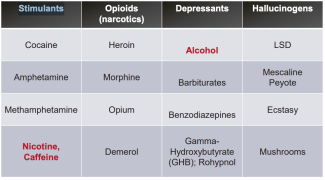Classification of Psychoactive Substances

This section from the UPC 2 Physiology and Pharmacology for Prevention Professionals (p130-133) introduces the main types of psychoactive substances, explains their effects on the brain and body, and clarifies that some commonly used legal substances are also psychoactive. It also highlights that certain substances do not fit neatly into the standard classification system and may produce mixed effects.
Classes of Psychoactive Substances
-
There are four main classes of psychoactive substances:
-
Stimulants – increase central nervous system (CNS) activity, raising heart rate and producing euphoria (e.g. cocaine, amphetamine, nicotine, caffeine).
-
Opioids (narcotics) – depress the CNS, relieve pain, and induce sleep (e.g. heroin, morphine, opium).
-
Depressants – decrease CNS activity, causing relaxation and drowsiness (e.g. alcohol, barbiturates, benzodiazepines).
-
Hallucinogens – alter mood and thinking, producing vivid sensory distortions (e.g. LSD, mescaline, ecstasy, mushrooms).
-
-
Nicotine, caffeine, and alcohol—though legal—are also classified as psychoactive substances.
Legal Substances
-
Legality does not equate to safety.
-
A substance being legal does not mean it is less harmful than illegal substances.
-
The legal status of a substance is often influenced by cultural, political, or religious traditions rather than by its actual level of harm.
Other Substances
-
Some drugs do not fit neatly into a single category, such as:
-
Cannabinoids (marijuana, hashish)
-
Khat/Miraa
-
Dissociative anesthetics (PCP, ketamine)
-
Inhalants (solvents, gases, nitrites)
-
-
These substances can produce mixed effects (e.g. stimulants at low doses, depressants or hallucinogens at higher doses), showing that the effect depends on both the type of substance and the amount taken.
